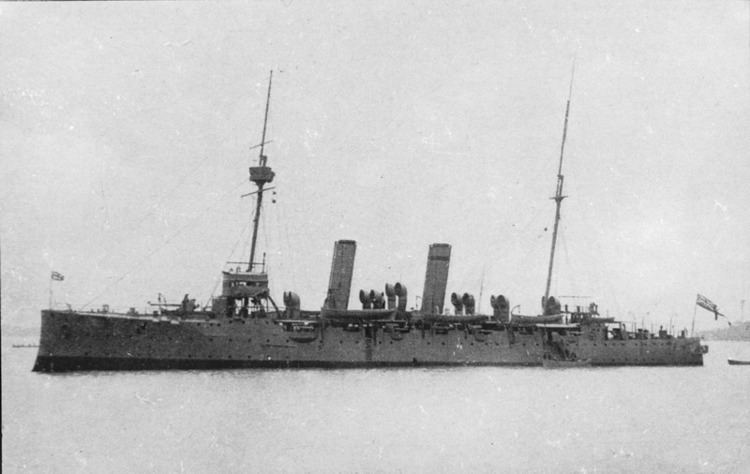Preceded by Astraea class Built 1893–1898 | Succeeded by Arrogant class In commission 1897–1921 | |
 | ||
The Eclipse-class cruisers were a class of nine second-class protected cruisers constructed for the Royal Navy in the mid-1890s.
Design and description
These ships were enlarged and improved versions of the preceding Astraea class. The Eclipse-class ships were 373 feet (113.7 m) long overall, had a beam of 53 feet 6 inches (16.31 m) and a draught of 20 feet 6 inches (6.2 m). They displaced 5,600 long tons (5,700 t) at normal load. To reduce biofouling, the hulls of the ships were sheathed with wood and copper. Their crew consisted of 450 officers and enlisted men. Their metacentric height was approximately 3 feet (0.9 m).
The Eclipse-class ships were powered by two inverted triple-expansion steam engines using steam generated by eight cylindrical boilers at a pressure of 155 psi (1,069 kPa; 11 kgf/cm2). Using normal draught, the boilers were intended to provide the engines with enough steam to generate 8,000 indicated horsepower (6,000 kW) and to reach a speed of 18.5 knots (34.3 km/h; 21.3 mph); using forced draft, the equivalent figures were 9,600 indicated horsepower (7,200 kW) and a speed of 19.5 knots (36.1 km/h; 22.4 mph). During their sea trials, all of the lightly loaded ships exceeded their specifications and reached a top speed of 20 knots (37 km/h; 23 mph). They carried a maximum of 1,075 long tons (1,092 t) of coal.
The ships carried five 40-calibre 6-inch (152 mm) quick-firing (QF) guns in single mounts protected by gun shields. One gun was mounted on the forecastle, two on the quarterdeck and one pair was abreast the bridge. They fired 100-pound (45 kg) shells at a muzzle velocity of 2,205 ft/s (672 m/s). The secondary armament consisted of six 40-calibre 4.7-inch (120 mm) guns; three on each broadside. Their 45-pound (20.4 kg) shells were fired at a muzzle velocity of 2,125 ft/s (648 m/s).
Defense against torpedo boats was provided by eight QF 12-pounder 12 cwt guns and six 47-millimetre (1.9 in) three-pounder Hotchkiss guns. Four of the 12-pounders were mounted in the sides of the hull fore and aft while the remaining four guns were interspersed between the 4.7-inch guns. The three-pounders were mounted in the fighting tops, three in each one. The 12-pounders fired 3-inch (76 mm), 12.5-pound (5.7 kg) projectiles at a muzzle velocity of 2,359 ft/s (719 m/s). The ships also equipped with three 18-inch torpedo tubes, one submerged tube on each broadside and one above water in the stern. The ammunition supply consisted of 200 six-inch rounds per gun, 250 shells for each 4.7-inch gun, 300 rounds per gun for the 12-pounders and 500 for each three-pounder. Each ship also carried ten torpedoes, presumably four for each broadside tube and two for the stern tube.
Between 1903 and 1905, all of the ships in the class except for Eclipse had their mixed armament replaced with a more uniform armament of eleven 6-inch, nine 12-pounders and seven 3-pounder guns.
The primary protection of the Eclipse class was its sloping armoured deck. This ranged in thickness from 1.5 to 3 inches (38 to 76 mm), with its slopes being 2.5 inches (64 mm) thick. It covered an area six inches above the waterline to 5 feet (1.5 m) below it. The engines were protected by a six-inch armoured hatch that extended above the armoured deck. The gun shields for the six-inch guns were three inches thick and the conning tower's armour was six inches thick.
